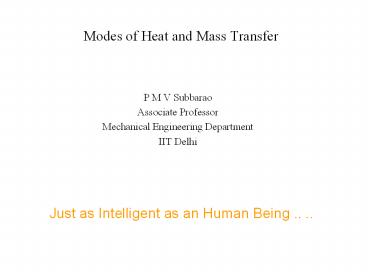Modes of Heat and Mass Transfer - PowerPoint PPT Presentation
1 / 24
Title:
Modes of Heat and Mass Transfer
Description:
Title: Engineering Thermodynamics Author: abc Created Date: 1/12/2004 10:50:19 AM Document presentation format: On-screen Show Other titles: Times New Roman Arial ... – PowerPoint PPT presentation
Number of Views:129
Avg rating:3.0/5.0
Title: Modes of Heat and Mass Transfer
1
Modes of Heat and Mass Transfer
- P M V Subbarao
- Associate Professor
- Mechanical Engineering Department
- IIT Delhi
Just as Intelligent as an Human Being .. ..
2
Modes of Heat Mass Transfer
- Conduction or Diffusion
- Convection
- Radiation
3
(No Transcript)
4
(No Transcript)
5
Circumstances Leading to Heat Conduction
6
The Chip Carrier
- The chip is housed in a chip carrier or substrate
made of ceramic, plastic, or glass in order to
protect its delicate circuitry from detrimental
effects of the environment. - The basic part
- The chip
- Bond
- Lead frame
- Bond Wires
- Lid
- Pins
- The design of the chip carrier is the first level
of thermal control of electronic devices.
7
Heat Generation Conduction through A Basic Chip
- The circuitry of an electronic component through
which electrons flow and thus heat is generated
is referred as the junction - Junctions are the sites of heat generation and
thus the hottest spots in a component. - Modern chips can with stand a Maximum Junctions
temperature of - 150 oC.
- Lower Junction temperatures are desirable for
extended life and lower Maintenance costs. - The basic thermal issue is Removal Heat
generated in 1 micron thick chip made of silicon
wafer.
8
Summary of Fouriers Law of Conduction
Global heat transfer rate due to conduction
9
Mathematical Description
- Temperature is a scalar quantity.
- Heat flux is defined with direction and Magnitude
A Vector. - Mathematically it is possible to have
Using the principles of vector calculus
10
Further Physical Description
- Will k be same in all directions?
- Why k cannot be different each direction?
- Why k cannot be a vector?
Will mathematics approve this ?
What is the most general acceptable behavior of
k, approved by both physics and mathematics?
11
Most General form of Fourier Law of Conduction
We are at cross roads !!!!!
12
Physical-mathematical Feasible Model
- Taking both physics and mathematics into
consideration, the most feasible model for
Fouriers Law of conduction is
Thermal conductivity of a general material is a
tensor.
13
Surprising Inventions !!!
14
Fire Resistant Wood
- Among the assessment properties of wood composite
of structural members in building construction,
fire performance is important and getting more
attention nowadays. - A new composite called molded carbon phenolic
spheres (CPS), a mixture of sugi wood charcoal
powders and phenol formaldehyde resin molded with
a hot press is developed by a research group in
Japan. - The heat due to a fire accident should be thrown
out fast outside the building.
15
Spread of Fire in A Room
16
Micro-structure of CPS
17
Thermal Performance
18
Another Physical Phenomena analogous to Heat
Conduction
- Diffusive Mass Transfer
19
Physics of Mass Transfer
- During a mass transfer process individual
chemical species travels from high concentration
region to low concentration region. - In this regard mass transfer is analogous to
heat transfer. - Conduction (Diffusion) Mass Transfer is governed
by Ficks Law of diffusion. - Fick's laws of diffusion were derived by Adolf
Fick in the year 1855.
20
Fick's law of diffusion
where C is the concentration, Jx is the rate of
mass diffusion, and D is the diffusion
coefficient.
21
In two or more dimensions
Equations based on Fick's law have been commonly
used to model transport processes in foods,
neurons, biopolymers, pharmaceuticals, porous
soils, population dynamics, semiconductor doping
process, etc. A large amount of experimental
research in polymer science and food science has
shown that a more general approach is required to
describe transport of components in materials
undergoing glass transition.
22
Heat Convection
- Convection uses the motion of fluids to transfer
heat. - In a typical convective heat transfer, a hot
surface heats the surrounding fluid, which is
then carried away by fluid movement such as wind.
- The warm fluid is replaced by cooler fluid, which
can draw more heat away from the surface. - Since the heated fluid is constantly replaced by
cooler fluid, the rate of heat transfer is
enhanced.
23
Natural Convection
- Natural convection (or free convection) refers to
a case where the fluid movement is created by the
warm fluid itself. - The density of fluid decrease as it is heated
thus, hot fluids are lighter than cool fluids. - Warm fluid surrounding a hot object rises, and is
replaced by cooler fluid. - The result is a circulation of air above the warm
surface
24
Forced Convection
- Forced convection uses external means of
producing fluid movement. - Forced convection is what makes a windy, winter
day feel much colder than a calm day with same
temperature. - The heat loss from your body is increased due to
the constant replenishment of cold air by the
wind. - Natural wind and fans are the two most common
sources of forced convection.































